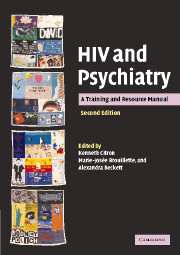Book contents
- Frontmatter
- Contents
- List of contributors
- Preface
- 1 Medical overview
- 2 Cognitive disorders in people living with HIV disease
- 3 General principles of pharmacotherapy for the patient with HIV infection
- 4 Mood disorders and psychosis in HIV
- 5 Suicidal behavior and HIV infection
- 6 Anxiety disorders and HIV disease
- 7 General issues in hospital HIV psychiatry
- 8 HIV and people with serious and persistent mental illness
- 9 Psychotherapy
- 10 HIV and substance use disorders
- 11 Psychiatric issues in pediatric HIV/AIDS
- 12 Uninfected children of parents with HIV
- 13 Psychological issues faced by gay men
- 14 Women and HIV
- 15 Couples
- 16A HIV and cultural diversity
- 16B African Americans
- 16C Latinos and HIV disease
- 16D One heart, two spirit, and beyond: HIV and the people of the First Nations
- 17 HIV in prison populations
- 18 Legal and ethical issues
- 19 Psychiatrist as caregiver
- Appendix I HIV Counselling checklist for physicians
- Index
- References
4 - Mood disorders and psychosis in HIV
Published online by Cambridge University Press: 06 August 2009
- Frontmatter
- Contents
- List of contributors
- Preface
- 1 Medical overview
- 2 Cognitive disorders in people living with HIV disease
- 3 General principles of pharmacotherapy for the patient with HIV infection
- 4 Mood disorders and psychosis in HIV
- 5 Suicidal behavior and HIV infection
- 6 Anxiety disorders and HIV disease
- 7 General issues in hospital HIV psychiatry
- 8 HIV and people with serious and persistent mental illness
- 9 Psychotherapy
- 10 HIV and substance use disorders
- 11 Psychiatric issues in pediatric HIV/AIDS
- 12 Uninfected children of parents with HIV
- 13 Psychological issues faced by gay men
- 14 Women and HIV
- 15 Couples
- 16A HIV and cultural diversity
- 16B African Americans
- 16C Latinos and HIV disease
- 16D One heart, two spirit, and beyond: HIV and the people of the First Nations
- 17 HIV in prison populations
- 18 Legal and ethical issues
- 19 Psychiatrist as caregiver
- Appendix I HIV Counselling checklist for physicians
- Index
- References
Summary
Introduction
Reported rates of depression among people infected with HIV vary. During the course of their disease, up to 85% of HIV-seropositive individuals report some depressive symptoms, and up to 50% experience a major depressive disorder. The variability across studies may be due to small sample size, population characteristics, and evaluation tools. However, in their meta-analysis of published studies, Ciesla and Roberts (2001) found that people with HIV were almost twice as likely as those who are HIV-seronegative to be diagnosed with major depressive disorder, and that depression was equally prevalent in people with both symptomatic and asymptomatic HIV. In their recent analysis of rates of depression and anxiety disorders in people with HIV, Morrison et al. (2002) found a fourfold increase in the risk of current major depressive disorder in HIV-seropositive women compared with an HIV-seronegative group.
The data regarding the prevalence of mania in people with HIV is scant. Although less common than depression, the risk of mania is still thought to be significant, particularly as the disease progresses (Ellen et al., 1999). Mania may be the behavioral manifestation of direct central nervous system (CNS) pathology or toxicity or, if the patient has a family or personal history of bipolar disorder, mania may suggest a primary affective disorder.
The occurrence of psychosis is not too surprising since people with HIV experience marked disturbances in dopamine metabolism (Berger et al., 1994). Early samples found frequencies ranging between less than 0.5% to 15% (Sewell et al. 1994).
- Type
- Chapter
- Information
- HIV and PsychiatryTraining and Resource Manual, pp. 88 - 109Publisher: Cambridge University PressPrint publication year: 2005
References
- 4
- Cited by

